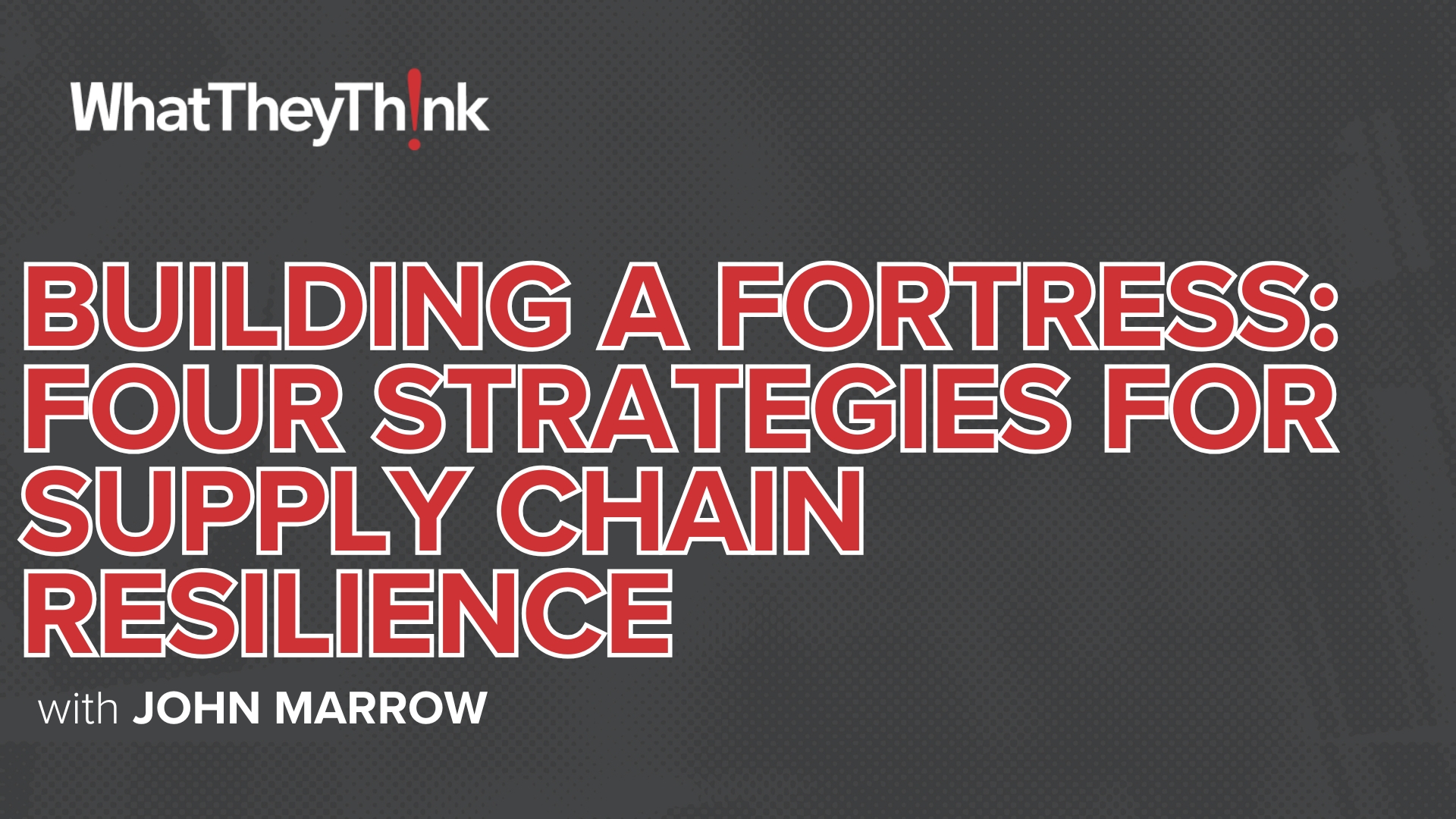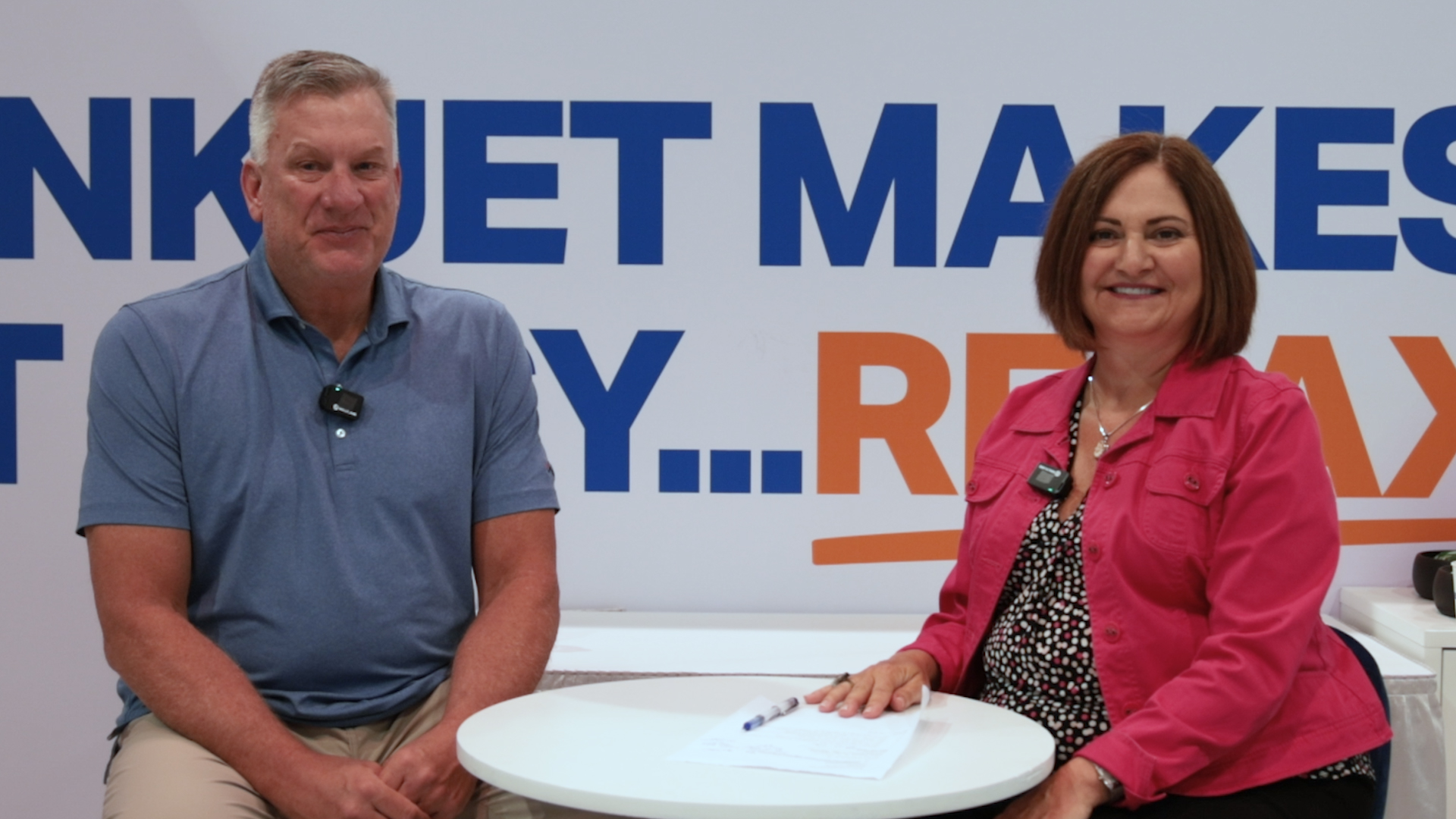Commentary & Analysis
Displaying 3501-3600 of thousands of articles
Insight You Need. Analysis You Trust.
Get the trusted insights you need to understand our evolving industry and emerging trends. Become a Premium Member.
Around the Web: E License Plates – Direct-to-Egg Printing – Mary Meeker’s Internet Trends Report – 36 Days of Type – This Week in Printing History
California experiments with E Ink-based license plates. Mary Meeker’s hotly anticipated annual Internet trends presentation has arrived. The first “cyberattack” took place nearly 200 years ago. A beautiful and brilliant collection of crowdsourced letter and number designs. ANA Acquires DMA. What happened this week in printing and publishing history. All that and more in WhatTheyThink's weekly miscellany.
USPS Challenge: “Mr. Scratch-Off” Digital Variable Scratch and Reveal Technology
In the ongoing search for new print techniques and technologies for mail, Trish highlights an exciting digital variable scratch-off collaboration between Mohawk, HP and Lawton Connect in Orlando.
Pricing for Digital Part 1: Overcoming Obstacles on the Path to Profitable Pricing
As digital delivery proliferates within the customer communications market, service providers with a legacy in print have been challenged to devise pricing models that position their operations for long-term sustainability. As part of its recently published research study entitled Pricing for Digital: Exploring New Models for Transactional Communications Delivery, Keypoint Intelligence – InfoTrends conducted more than a dozen in-depth interviews with print service providers in North America to gain a deeper understanding of the primary pricing obstacles that stakeholders face in today’s changing market. The first in a three-part series, this article explores the hurdles that providers encounter in the market and considers the approaches they have developed as they attempt to establish profitable pricing models.
Learn from Print Sales Losses
When you lose a sales deal, how does your company react? Do you have a culture of learning from losses or do you have a culture of blaming? A sales loss is a treasure trove of learning—successful companies evaluate and adjust for their next pitch.
Looking for Cool Leggings? Check Out Bombsheller and Its On-Demand Manufacturing Model
Pablos Holman is a serial entrepreneur whose latest venture is Bombsheller, an online source for leggings manufactured on demand. Customers can select from more than a thousand designs, or upload their own, and each pair of leggings, which are available in 10 sizes, is digitally printed, cut, and sewn, with shipment in 24 hours in most cases.
What Do These 5 “Mail Trends” Tell Us?
These five mail trends from DirectMail 2.0 raise interesting questions about how we are (or are not) proving the value of print and the opportunities that are lost when we don’t.
Breaking Into the “European” Print Market: Understand Geographies and Cultures
Morten Reitoft of INKISH.TV kicks off a new series of editorials offering advice for U.S. companies seeking to enter the European print market. In this first installment, Reitoft stresses that “Europe” is not a single, monolithic market.
Kudos to Canon Solutions Americas on Great QR Code Implementation
Canon Solutions America’s use of QR Codes in a recent white paper is a great example of everything done right. This is a model of how to do QR Codes well.
Around the Web: Investing in the Swamp – The Quest for Red Pigment – Scented Postage – The Retail Apocalypse Deferred – Blockchain and Digital Signage – Towel Day
Investing in companies by how much they spend on lobbying. Searching for a safe, bright red pigment. Making your mail smell like popsicles. Exaggerating the death of retail. All that and more in WhatTheyThink's weekly miscellany.
Highlights from the 2018 National Postal Forum
Earlier this month, the National Postal Forum (NPF) celebrated its 50th anniversary in San Antonio, Tex., with more than 4,000 professionals from the mailing and shipping industry. In addition to the five primary educational tracks over the four-day event, NPF had nearly 130 exhibitors in the exhibitor hall. This analysis provides highlights from the NPF’s Opening General Session, as well as an overview of the USPS’s latest innovations.
Microfactories and Automation the Stars at TechTextil/TexProcess
WhatTheyThink attended TechTextil/TexProcess in Atlanta, and one of the key messages that came out of the show was the fact that apparel microfactories are a reality. This brings many advantages to the apparel industry, especially in North America and Europe where there is a move to re-shore some part of apparel manufacturing.
Lumii: A Unique New Solution for Label and Packaging Security
At RADTECH, David Zwang saw an interesting solution from a young startup company, LUMII, for label and packaging security. Imagine a high-tech moiré that can provide visually 3D security printing inline without the need for external embellishments or to apply post print.
Web-to-Print is a Tool for Your Customers
Prepress automation, streamlining your customer service department, and reducing the time between inquiry and jobs getting on press – these are common feature requests for web-to-print systems. They are all about you (the printer) – web-to-print isn’t about you! Web-to-print is for your customers!
In The Mail: May 2018 - What You Need to Know About Postal Issues
NPF Report: USPS puts the spotlight on Informed Delivery & Informed Visibility; PMG Brennan speaks of “shared purpose”…BOG nominees advance…Taskforce gets August deadline…Senator proposes postal banks.
Good News Could Be a Full-Time Job, but for Most Economists It’s Only Part-Time
Some people say that the news is always bad, and they wish someone would report good news now and then. There is good news but no one seems to report it. You’d think that would be a full time job for someone. The economy has set a record for full time employment, and all we hear are crickets. The economy has been doing better lately in some key measures of employment, but the Fed is scaring markets by preparing to raise rates. TINA, meet TAMA, the result of the Fed’s actions; don’t worry, we’ll explain it. The statisticians at the Commerce Department revised printing shipments data. Revising data seems to be a full time job in the Beltway. Dr. Joe clarifies it all for one nearly last time.
Textiles and Corrugated Take the Spotlight at FESPA Berlin
Textiles and corrugated were the two major themes of this year’s FESPA Global Print Expo. Here are some quick hits from the show.
Consumer Durable Goods Orders Moving at Almost 2X GDP Rate
Durable goods orders for consumers (less transportation) are growing at a rate almost two times faster than Real GDP. This data series remains -14% below where it was at the start of the recession in December 2017, and is a critical one to monitor for indications of an improved economy.
Around the Web: Digital ad Revenue - Digitally Colored Embroidery - Media Consumption Habits
Digital ad revenue, digitally colored embroidery, and curbing your media consumption. All that and more this week in WhatTheyThink's weekly miscellany.
Throwback Thursday, Bindery Edition: Trish Asks Trade Binderies About Their Most Useful Vintage Machines
In this special Throwback Thursday feature, Trish reaches out to trade binderies to hunt for funky vintage machines that are still useful in today’s modern workflow. This first edition features fascinating finds from four well-known US binderies.
Quad/Graphics Accelerated Insights: A Digital Revolution in Direct Mail Testing
Quad/Graphics has launched Accelerated Insights, a cloud-based software tool to enhance—and some might even say revolutionize—direct mail testing. This article explores the features of Accelerated Insights and describes its effects on direct mailing.
Flies on the Wall: On Sale Now
Psychographic targeting is easier than ever. But can it be trusted? If it can, why aren’t more printers using it? A look inside psychographic targeting and its benefits.
Delegate the Right Jobs to Software
Every industry is being transformed by a new staffing option for the “jobs to be done” and that staffing option is software. Your business needs to get stuff done—some of that stuff needs to be done by humans and a lot of that stuff needs to be done by software.
FESPA Day 2: Whetting the Palate...
WhatTheyThink is live at FESPA Berlin 2018 on Day 2 of the show. Welcome to the concept of the microfactory.
Intelligent Packaging Creates New Markets for Print Industry
In 2018, the combined active and intelligent packaging market value is projected to reach $5.68 billion and will continue to present new value-adding options in the future according to the latest market analysis from Smithers Pira. Read on for more highlights of Smithers Pira’s latest report.
FESPA 2018 Opens in Berlin
The FESPA Global Print Expo 2018 kicked off in Berlin this morning. Here is a quick teaser of some early show highlights.
Where Are Marketers Getting Their Data?
According to new research, marketers are increasingly investing in second- and third-party data to create 360-degree views of their customers. Are your customers doing the same? Are they prepared to compete? Read more.
Wide Format: Now and Venn
What do we talk about when we talk about “wide format”? How is the term definitionally changing—and what does it even mean anymore? And more importantly, how does whatever we define as “wide format” play nice with other kinds of printing such as industrial, packaging, and commercial? And how can we navigate the “convergence” of these different print silos? Read on for more.
Q1-2018 Rises +2.3%, Slower Rate than Q4-2017
The Bureau of Economic Analysis’ advance report estimated that Q1-2018 real gross domestic product was up at an annual rate of +2.3%, which was slower than the +2.9% for Q4-2017. Because companies and individuals, especially corporations, shifted expenses into 2017 and delayed revenue recognition to 2018 to take advantage of the rates in the new tax law, many key economic data series—such as this one—will be subject to larger than usual revision.
Around the Web - Recommended Reading from the WhatTheyThink Team
Blockchain, Buffett, and blurring boundaries. Silk and sneakers. One space or two? WhatTheyThink’s new regular Friday feature, Around the Web, presents a miscellany of random news items that caught the attention of our contributors this week. Read on for more.
Marketing and Publishing Guru Seth Godin to Keynote PRINT 18
Seth Godin, world-renowned entrepreneur and marketing and publishing guru, will be keynoting this September’s PRINT 18. Cary Sherburne spoke to him about the changing role of print in today’s marketing and publishing landscape. Read on for some insights from one of today’s thought leaders.
New Trends in Color Management
Managing color in today’s ever-changing environment has long been a challenge for printers. No two scanners, monitors, or printers will reproduce colors identically, making it necessary to implement specialized color management systems to achieve an exact match across devices. This article explores some of the options that are available for printers.
Xerox: Innovation and/or Investment
Xerox has just introduced the very interesting Xerox® IridesseTM Production Press into the global market, the latest electrophotographic machine in its product lineup. With all of the media hype surrounding the Xerox Fujifilm merger, this new press shows how well Xerox and Fuji Xerox can work together to create technology that brings innovation and value to the market and the company, something you may not be hearing in the distracting news streams. Read on for more.
The Pre-Mortem to a Print MIS Transition
If you’re on your way to embarking on a Print MIS transition, then you need to sit down and pretend the whole thing was a spectacular failure. Once you’re in that uncomfortable place—work backwards and build a plan to prevent its untimely death.
How MakerBot Is Shaping a 3D Future in Industry and Education
For a dozen years, Forrest Leighton held marketing roles at Canon USA, and then spent four years with Marcomm Central. Today, he is Vice President of Marketing at MakerBot, a Stratasys company and a global leader in desktop 3D printing solutions. Senior Editor Cary Sherburne spoke with him recently to learn more about MakerBot and how 3D printing might be a relevant opportunity for commercial, sign & display graphics, packaging and textile printers.
Getting Flexible in Your Middle Years – April 2018 M&A Activity
Transcontinental TC closes transformative transactions, ProAmpac buys, commercial printers actively acquire; Herbie finally retires, and more.
Standfast & Barracks: Naught to 50% Digital Textile Printing in Five Years
Changing market dynamics, including the increasing proliferation of digital printing technologies for textiles and apparel, are boosting reshoring efforts in many countries. UK-based Standfast & Barracks has worked closely with digital textile printer manufacturer Durst to help accelerate this trend using its Durst Alpha Series digital textile printers. Read more.
InPrint Reflections: Moving the (Digitally Printed) Goalposts
A major theme of last week’s InPrint Industrial Inkjet Conference in Chicago was the emerging distinction between two specific kinds of industrial printing: printing as part of a larger manufacturing process and what we have often called specialty printing. The conference explored the differences between them, where the growth areas are, and what the drivers of that growth are. Read on for some reflections on the conference.
A Big Focus on Small Print Shops
Smaller print shops face many of the same challenges as larger shops, so the need for a single system of record to manage the business is just as critical. Until recently, the only solution was purchasing an expensive print MIS with integration capabilities and pay for professional services to set up the connectivity to the other software solutions. This article explores how things are beginning to change for the better for small print shops.
Faces of Finishing: Julie Watson of Ultimate TechnoGraphics on Building Software for Prepress-to-Finishing Automation
In the latest installment of this interview series, Trish Witkowski talks with Julie Watson, CEO of Ultimate Technographics, about developing software that drives value by eliminating touchpoints in the bindery.
Stunning 3D Printed Garments a Revolutionary Idea
Tel Aviv-based fashion designer Danit Peleg creates custom garments and accessories using desktop 3D printers. Today, Peleg is also in the process of creating and uploading to her site designs that can be downloaded and printed. Read on for more on her unique projects.
Your Customer’s Workflow Challenges are Your Opportunities
There is a conflux of pressures on businesses today: increase speed, personalize products, respond to the market faster, localize the messaging, and do all this with less people on a tighter budget. Read on for tips on how to cope with these challenges.
How Do You Build Efficiencies through a Print Quality Management Program? 3M Has Perspective
One of the high points of the Color Conference held earlier this year was a talk by Lisa Price, Design Operations Director at 3M. I was able to speak to Lisa recently to get a little more detail about her very successful Print Quality Management Program that helps her manage a network of more than 700 printers worldwide. Read more.
E-commerce Is a $20 Billion Market for Corrugated Packaging—and Growing Fast
New research from Smithers Pira points to major growth for corrugated in serving the fast-developing e-commerce packaging markets. Read on for more detail.
Israeli Fashion Designer Leverages Digital Textile Printing for New Business Model
Fashion designer Michal Ratzman turned to digital textile printing to find a way to make her dress design business more attractive to buyers and more profitable for her. By switching to the sell-then-manufacture model from manufacture-then-hope-to-sell, she is able to provide more customized apparel solutions while eliminating returns, inventory and waste for her on-demand dress manufacturing business, byme.
Direct-to-Shape: An Intriguing Corner of Digital Print for Packaging
Within the direct-to-shape printing for packaging market, digital printing is generally growing as a complement to offset, flexo, and other analog presses that print labels, folding cartons, flexible packaging, and corrugated. This article explores the direct-to-shape market by answering some basic questions about it.
In The Mail: April 2018 – What You Need to Know About Postal Issues
President Donald Trump signs an Executive Order forming a Task Force to evaluate operations and finances of the U.S. Postal System…The PRC Scolds the USPS for performance shortfalls…Promo standstill…No returns needed.
Paul Marino of Impress Communications Puts 100% Accuracy into Practice with “Picture-Perfect” Bobst ACCUCHECK System
Trish visits the team at Impress Communications in Chatsworth, Calif., and speaks with owner Paul Marino about the challenges and the benefits of installing a 100% accurate quality control inspection system on their Bobst EXPERTFOLD folder-gluer line.
"Do I Have to Go Through an Account Manager?"
Our important customers get our attention and our dedicated resources. What happens when customers prefer online tools over dedicated resources? Read on to find out.
Millennial Marketer: “I Don’t Use QR Codes”
If anyone is using QR codes, it’s Millennials, right? If anyone understands the value of QR codes, it’s marketers. So why doesn’t this Millennial marketer use them? Read on to find out.
SEAMS: Supercharging the U.S. Apparel Supply Chain
In preparation for attending TechTextil/TexProcess in Atlanta in May, Senior Editor Cary Sherburne connected with Will Duncan, Executive Director of SEAMS, a trade organization dedicated to empowering the Made in America movement by supercharging the U.S. supply chain from concept to customer. Learn more about SEAMS and the benefits of joining the effort.
Moving Pictures: Carbon Wraps Brings Art Alive
For about 15 years, Carbon Wraps Orlando has specialized in highly creative vehicle graphics. They took car wrapping to the next level when they worked with local artist Kurt Meister and Avery Dennison to wrap one of his paintings on a vehicle live at the ISA Sign Expo last March. Read on for more about the company and this unique project.
A Significant Speed Boost and Cost Reduction with Hybrid Production Inkjet for Flexible Packaging
UTECO Group, in conjunction with Kodak, has released and will be installing the first Sapphire EVO aqueous-based production hybrid inkjet press for flexible packaging. This newly designed press significantly raises the bar on production speed while lowering operational costs compared with existing digital solutions.
On Demand Manufacturing: A Sea Change for the Apparel Industry
Can apparel be completely manufactured in an automated environment? Not yet. But it’s coming soon and will revolutionize apparel manufacturing. Learn how NextWave, and its partners EFI, Klieverik, Zund, and Henderson are creating an on demand microfactory, which will be on display at TechTextil/TexProcess in Atlanta in May.
The Migration to Digital Continues... But Printed Customer Communications Remain Popular
The results from InfoTrends’ annual transactional communications survey uncovered some surprising shifts in opinions about paper-based and electronic communications. This article cites recent survey data to explore how printed and electronic bills and statements continue to coexist in the customer communications market.
How Is Your Mobile Competency?
Mobile Internet usage continues to grow, including the percentage of users who are mobile-only. Consequently, multichannel marketing strategies must incorporate the full mobile experience. Is your mobile competency keeping pace? Read on to see.
Embedding Real Print Workflow Change
A print software application can do certain jobs for your business. Once you’ve proven it works, don’t forget to execute. Deploy the software so it does that job across your entire organization. Read on to find out how.
Unique Great Northern Solution Fills the Gap Between Corrugated and Folding Carton
Great Northern Corporation added an HP PageWide T400S inkjet press to its operation last year to bring more flexibility to its unique ultra-strong folding cartons. In this post, learn how Great Northern is leveraging offset and digital for more efficiency, and the approach the company has taken to filling the gap between corrugated and folding carton.
Move Over for Mouvent’s New Digital Textile Printer
Following its announcement of its formation as a joint venture between BOBST and Radex last July, Mouvent is now bringing its innovative textile printers to market. Senior Editor Cary Sherburne spoke with Ghislain Segard, Marketing & Sales Manager for Textile Machines at Mouvent, to get more details about the current product and Mouvent’s strategies for the future. Read more.
Lost in the Economy: Patience
“Staying the course” does not refer to golf, but might be an answer to “Aren’t we there yet?” When all of your economic models are based on something old, and not something new, that could make you blue, and confused. Since we’re now talking about weddings of the business kind, the Amazon-USPS wedding has gotten a lot of press lately. Don’t they take such a pretty picture together? Well, maybe not. The relationship solves one problem and creates another. No, not the in-laws again… what do they want now?
Rarity: Another Reason (Good) Personalization Works
Despite all the talk about personalized mailings, how often do any of us really receive relevant data-driven direct mail? Is the rarity of truly personalized mail part of what makes it effective?
Federal Reserve Updates Industrial Production Data Series
The Federal Reserve revised 2015–2017 industrial production down from its original reports, meaning that industrial production peaked in 2014 and then slowed. The initial data made things seem better than what consumers and employees were actually experiencing.
Print, Personalization, and Media Integration: Delivering Results to SMBs
Small and medium-sized businesses (SMBs) offer a great deal of opportunity for print service providers. This article highlights key communication trends and opportunities in the SMB market, as identified in Keypoint Intelligence – InfoTrends’ recent research study In Search of Business Opportunities: Finding the Right Prospects.
To Robotize or Not? The Real Numbers Behind Production Chain Productivity (Part 2 of 2)
In the second of this two-part feature on production chain productivity, guest-writer Henrik Christiansen of Graphic Robotics addresses the quantitative aspects of automation, and how the robotization of finishing processes in the appropriate production environments can greatly reduce labor costs and improve productivity. Read on.
In Praise of Data: How PRIMIR Industry Research Can Improve Your Business
The Association for Print Technologies (APTech), through its PRIMIR Research Unit and Market Data programs, provides a wealth of woefully underutilized industry research that can be of great practical use to all the links in the print supply chain—not just suppliers and vendors but print service providers, as well. Read on to see how.
Harlequin 12: PDF 2.0 and Then Some, Almost Ready for Prime Time
Global Graphics today announced what appears to be the first PDF 2.0-compatible RIP/Renderer available to OEM partners. Technology Editor David Zwang delves into the details and explains what this means for the market. Read more.
The Culture of Business Meetings
The meeting is a tool that should be used sparingly. It is expensive. It is for a specific purpose (alignment, understanding, status check-in, etc.). It is overused and the art of running a good meeting is underrated.
HP PIAZZA: A Solution to Organize and Streamline Book Publishing
Zwang and Sherburne tuned in to HP’s analyst briefing concerning today’s announcement of PIAZZA, a cloud-based solution designed to make the book publishing supply chain more efficient. By integrating with PrintOS Site Flow, PIAZZA aims to deliver a near-touchless end-to-end book publishing and printing process. Read more.
Bespoke and Hybrid Processes and Manufacturing: Facilitating Technologies Part 2—The Successful Marriage of Ink and Media
In this series, David Zwang will look at the new requirements for print and packaging manufacturing, and how the demands and opportunities of Industry 4.0 are being facilitated by new bespoke production and workflow methods. In this article in the series, he looks at ink and why it is the key technology.
Retail’s Returns Conundrum and How Digital Textile Could Help
Retailers are seeing an unprecedented volume of returns, according to a recent eMarketer Retail story, and they are struggling with how to deal with this while still keeping margins at an acceptable level. Many are burdened with legacy supply chain issues that digital technology could mitigate. This post is a recap of some of the innovative approaches to digital textile and apparel manufacturing that are poised to revolutionize the world of textiles and apparel.
A Wrap to Remember: Kennickell Group Turns Harbour Town Lighthouse Plaid
If you watch the RBC Heritage Golf Classic this week, pay attention to the iconic Harbour Town Lighthouse. In a first-of-its-kind wrap project undertaken by Savannah, Ga.’s Kennickell Group, the 90-foot structure had its red stripes converted to plaid to commemorate the event’s 50th anniversary. Read on to find out more about the company’s dramatic growth in the wide-format market and how the unique project came about.
FESPA 2018 Features “Print. Make. Wear.” Trend with Special Exhibit
Are you going to FESPA 2018 in Berlin? If so, there’s a special treat in store that you will not want to miss. In this article, show organizer Duncan MacOwan explains FESPA’s Print. Make. Wear. exhibit that showcases how digital technologies are transforming textiles and apparel while also demonstrating the ongoing value that analog production processes still add to the mix. Read more.
Press Onward!—March 2018 M&A Activity
German and American rivals agree to merge, Contiweb spun off, Sun and Siegwerk acquire specialty inks, Autajon strengthens US presence, and more.
InPrint Industrial Inkjet Conference to Highlight the Intersection of Industrial and Commercial Printing
Inkjet technologies have been blurring, or completely eliminating, the lines between commercial and industrial printing. But understanding new print applications and new print markets involves more than technology. We talk with Frazer Chesterman, Director of FM Brooks, which is bringing the InPrint Industrial Print Conference to Chicago next month, about the dwindling distinction between industrial and commercial printing and the opportunities that are emerging.
Q4-2017 GDP Revisions Stronger than Earlier Reports
Q4-2017 GDP estimates were raised to +2.9% from the original estimate of +2.5%. (But beware inventories.) At the same time, shenanigans resulting from the latest tax bill are blurring statistics visibility, especially where corporate profits are concerned.
The Value of Platforms: A Revolution is Coming!
All printers are seeking ways to embrace a business and production infrastructure that enables them to add new tools as needed and depreciate tools that no longer serve a need. This article provides a brief overview of the platforms that facilitate these skills as well as a specific example of the Chili Publisher platform.
Productivity and the Total Profitability of the Print Production Process (Part 1 of 2)
Henrik Christiansen of Graphic Robotics writes about the real meaning of productivity and efficiency in the print production process. This two-part article will address the quantitative side of automation in print.
Two Reasons This QR Code Should Work—and One That Makes It Fail
We love to hate QR Codes, right? But it’s not the codes themselves that are working against near unanimous consumer adoption. It’s the often rookie mistakes made by marketing departments. Are you letting your customers fail at QR Codes unnecessarily?
The First Few Weeks Using New Print Software
When new software is implemented in your native environment – that’s when the real learning happens. Everything prior to that point was theoretical. Take this time to learn how this software uniquely meets the needs of your business.
Post-Reed, Communities Reevaluate their Sign Codes
The landmark 2015 Supreme Court case Reed v. Town of Gilbert turned a sign code issue into a First Amendment battle. Three years later, its effects are still being felt throughout the signage industry—for good or ill. Read on for some of the latest developments in signage regulations.
Go, NextPage! Congrats on a Great Self-Promo Campaign Demonstrating the Value of Combining Social Media, Video, with Direct Mail
If MSPs want to convince their clients of the value of multichannel marketing, they must be willing to use it to promote their own businesses. That’s why I was excited to see NextPage launching a really fun campaign combining direct mail, email, video, and social media, along with a targeted digital ad buy.
Spoonflower: Demonstrating the Potential of Digital Textile Printing
Durham, N.C.’s Spoonflower allows users in its community of more than 3.5 million individuals to design and digitally print their own custom fabrics for curtains, quilts, clothes, bags, furniture, dolls, pillows, framed artwork, costumes, banners, and much, much more. Read on to see how Spoonflower is continuing to transform the digital textile printing market.
Dr. Joe: It’s Time to Stop Cooperating with Postal Reform
Forget postal reform; Dr. Joe Webb calls for privatization of the postal system.
TAGA 2018 and the Future of Graphic Arts Research
Frank Romano reports from the 70th TAGA Annual Technical Conference, held March 18–21 in Baltimore, Md.
Faces of Finishing: BindTech/Finish Line Bindery Owner John Helline On the Trade Bindery As an Investment Target
In the latest installment of this interview series, Trish Witkowski talks with bindery owner and investor John Helline on the pitfalls and the strategic opportunities involved in the trade bindery business.
The Customer Experience Potential of Critical Communications
Today’s empowered consumers are conditioned to expect instant access to information, goods, and services. These expectations are forcing businesses to reconsider their marketing strategies. This article cites recent research from Keypoint Intelligence – InfoTrends highlighting the importance of a positive customer experience in driving revenue growth and improving customer satisfaction.
HYBRID PACKZalyzer Brings Packaging Tools to HP PrintOS
At DScoop 2018 this week, HYBRID Software announced PACKZalyzer, HP PrintOS-compatible software that “will allow order entry or customer service personnel to receive files from clients and get them ready for production before they enter the prepress department.” David Zwang comments on this announcement.
The Changing Role of Print Sales Representatives
Your sales team must do more than sell. They must be good learners (that means less talking, more listening, and more curiosity about how they can help their customers). Your customer’s time is valuable. When they give you their time they are voting on your value.
Bespoke Processes and Manufacturing: It Can Be Done, but Where to Begin?
In this series, David Zwang will look at how the new requirements of print and packaging manufacturing, and how the demands and opportunities of Industry 4.0, are being facilitated by new bespoke production and workflow methods. He will look at the requirements, technologies, methods, and educational processes necessary to bring it all together. In this article, he looks at some of the issues that can and should drive a decision.
In the Mail: March 2018 - What You Need to Know About Postal Issues
An industry coalition of more than 50 mailing stakeholders expresses opposition to the ratemaking plan proposed by the Postal Regulatory Commission; the USPS rolls out an electronic payment system, reduces truck mileage, continues to lose money. Read on for this month’s postal system update.
The Traditional Meets the Technological at Sign Expo 2018
The International Sign Association (ISA) Sign Expo 2018 was held in Orlando, Fla., last week. Channel letters, magnetic signage, neon lighting, LED displays, digital displays, 3D printing, and wide-format and display graphics in all their various incarnations were being showcased. Read on for some highlights from the show.
Show and Tell
As the current industry trade show landscape changes, Frank Romano looks back at how the trade show landscape has always been changing.
Developing Sales Talent Requires Coaching!
When it comes to managing—and more importantly coaching and developing sales talent—the skills that are required are different than the ones that make a good salesperson. This article highlights research from Keypoint Intelligence – InfoTrends to explore how high-growth sales organizations develop the best talent.
HP Announces New Product Family Featuring Latex Rigid Technology
At an ISA preview event last night, HP presented a new technology for Latex printing on rigid substrates up to two inches thick. Although pricing and availability are not yet available, the company showed sample prints and plans to demonstrate the machine in operation at FESPA in Berlin in May. Learn more.
Epson Dedicated to Speeding Adoption of Digital Textile Printing
Epson’s 2018 Digital Couture Project leading up to New York’s Fashion Week caught my attention, and I reached out to the Mark Radogna, Strategic Marketing for Epson America, to learn more about how Epson is approaching the digital textiles market and where the company sees it going in the future.
Print Software Bootcamp at Dscoop 2018
Your business toolset is changing; software is becoming one of the most important tools for managing, growing, and innovating your business. At Dscoop next week, we are conducting a Print Software Bootcamp to help Dscoop Members learn more about the Print Software toolset.
Are You Distinguishing Between Macro and Micro Conversions?
Are you helping your clients track both micro and macro conversions? If not, you’re losing opportunities to understand not just what works and what doesn’t, but why.
Retail, Transportation, and Manufacturing Central to Hot Future of Thermal Print Supply
New Smithers Pira Research forecasts strong growth for thermal printing, identifying retail, transport, and manufacturing as the top three applications for thermal printing equipment and supplies. Read on for an overview of the thermal printing market from 2018 to 2023.
Conflicts, Inconsistencies, and Misrepresentations: Situation is Normal
Trade tariff talk has confused the markets, but so have the recent economic data. Employment data look great, retail sales look bad, consumer confidence surges in the lowest third of households by income. Explain that, Dr. Joe! He does, and offers insight into the selection of Larry Kudlow as the President’s economic advisor. There may be no free lunches, but Dr. Joe has some free podcasts and a webinar. Get them now before someone proposes a tariff on electrons.
Breakthrough Material Makes Heat Transfer News
As a garment decorator or textile printer, have you ever bemoaned the fact that you have to pretreat natural fiber fabrics in order to use heat-transfer sublimation for a brilliant, durable image on natural fiber textiles? Moan no more! The Mosaica Group is introducing a breakthrough product from a European mill that makes heat transfer news. Read more.
Latest WhatTheyThink Webinar Looked at the Current Economic Climate and Print Business Conditions
Last Wednesday, Dr. Joe Webb presented his quarterly economic conditions webinar, which included a look at the overall macroeconomic environment as well as current printing industry business conditions. Read on for a brief summary of what Dr. Webb discussed.
- Questions to ask about inkjet for corrugated packaging
- Can Chinese OEMs challenge Western manufacturers?
- The #1 Question When Selling Inkjet
- Integrator perspective on Konica Minolta printheads
- Surfing the Waves of Inkjet
- Kyocera Nixka talks inkjet integration trends
- B2B Customer Tours
- Keeping Inkjet Tickled Pink
© 2024 WhatTheyThink. All Rights Reserved.














